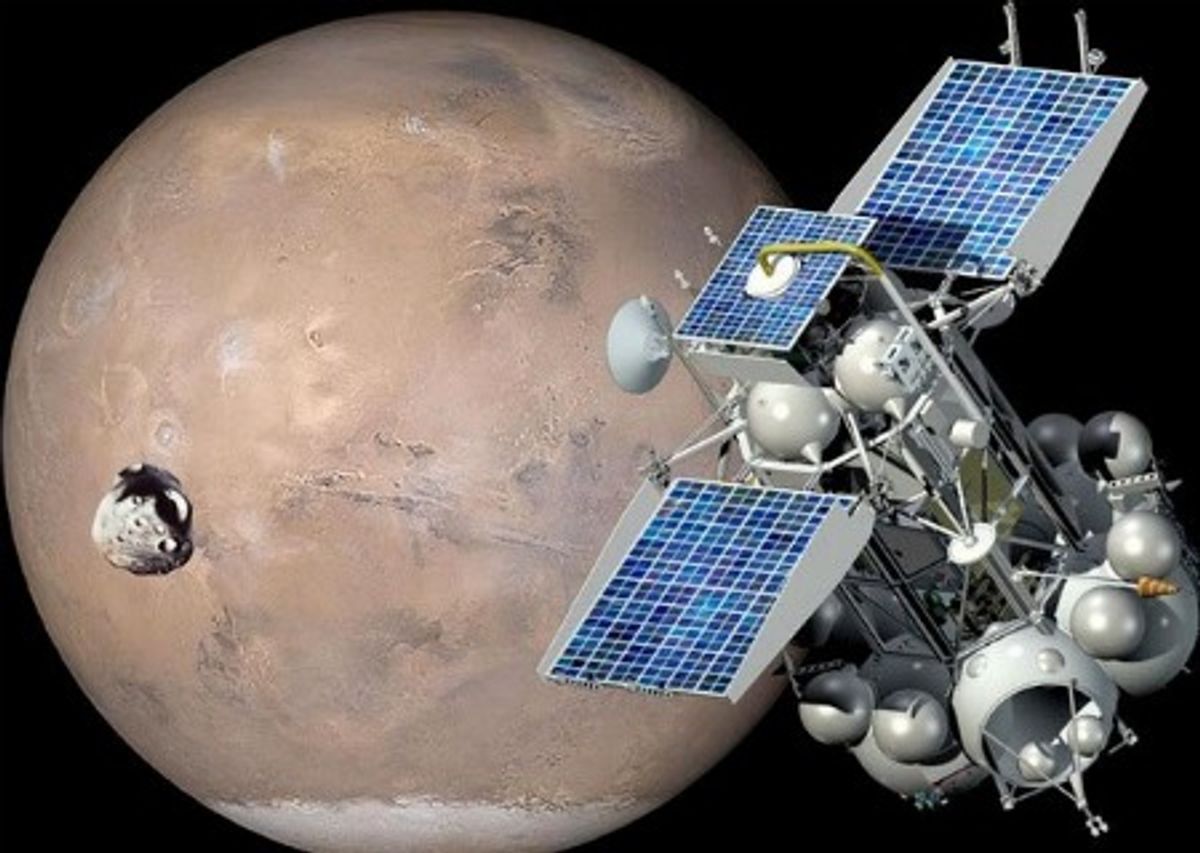Things aren’t looking too great for Russia’s Phobos-Grunt spacecraft. The launch window for the probe's round-trip mission to the Martian moon Phobos ended on Monday, and the spacecraft is still stuck in Earth orbit.
Phobos-Grunt is Russia’s first attempt to reach Mars in 15 years. Hopes were high for the mission. But after a successful night launch on November 8, the spacecraft failed to make the two engine firings it needed to begin the trip to Mars. Two weeks later, ground controllers still haven’t been able to establish communication with the probe. According to RIA Novosti, the spacecraft has unfolded its solar panels and is in “barbecue mode” – rotating slowly to keep the sun from overheating any one side.
No one’s quite sure what’s gone wrong, but one leading hypothesis, says MSNBC's Alan Boyle, is that there was some fault that led to the engine failure, and that “Mission Control can't send the commands to reset the software because the fuel tanks are blocking an antenna that needs to be clear.”
According to David Warmflash, the scientific lead for a biology experiment on board the spacecraft, Phobos-Grunt is thought to have entered safe mode and is extending its time in orbit by periodically using small thrusters. In a post to Universe Today, he explains that recovery would have been easier if the spacecraft had managed to make the first engine firing:
Had the malfunction occurred just one step further into the flight –after a first burn of the Fregat [main propulsion unit] was to raise the apogee (the highest point) of the spacecraft’s orbit to an altitude of about 4,170 kilometers– the timing and geometry between Earth-bound transmitters and the spacecrafts antennae would have made signaling the craft a straight forward task. But with Grunt orbiting much lower (thus moving much faster with respect to the ground), and with an antenna that could receive the signal obstructed partially by a fuel tank that was to be jettisoned after the first Fregat burn, controllers have only a couple of minutes at a time to attempt communication. Since the spacecraft was not designed for this scenario, getting her attention may be depend on…getting the signals toward her at some unlikely angle. In other words, restoring control over Phobos-Grunt may be a matter of luck.
No one seems too hopeful about recovering the spacecraft. "We have to be realistic," Interfax quotes Roscosmos deputy chief Vitaly Davydov. "Since we haven't been able to get in touch with it for such a long time, chances to accomplish the mission are very slim."
Despite that grim assessment, there has been no official word that the mission is over, and some reports, including this analysis by RIA Novosti commentator Konstantin Bogdanov, suggest that some sort of mission to Mars is still possible. The expiration of the spacecraft's launch window means Phobos-Grunt won’t be able to accomplish its original mission: land on Phobos, collect a sample of Martian moon dust, and return to Earth. But Bogdanov says at least one official believes the spacecraft could still make a one-way trip to the Red Planet. If it did that, Phobos-Grunt could deliver China’s very first Mars orbiter to the Red Planet, a small spacecraft called Yinghuo-1 that piggybacked on the launch.
That is, of course, if officials can establish contact with Phobos-Grunt and get its engines to fire. It’s looking increasingly likely that the spacecraft will simply fall to Earth, carrying with it about 11 tons of unused propellant. Officials say the probe will reenter Earth's atmosphere no earlier than January and should explode before it hits the ground.
(Image: Roscosmos)
Rachel Courtland, an unabashed astronomy aficionado, is a former senior associate editor at Spectrum. She now works in the editorial department at Nature. At Spectrum, she wrote about a variety of engineering efforts, including the quest for energy-producing fusion at the National Ignition Facility and the hunt for dark matter using an ultraquiet radio receiver. In 2014, she received a Neal Award for her feature on shrinking transistors and how the semiconductor industry talks about the challenge.



